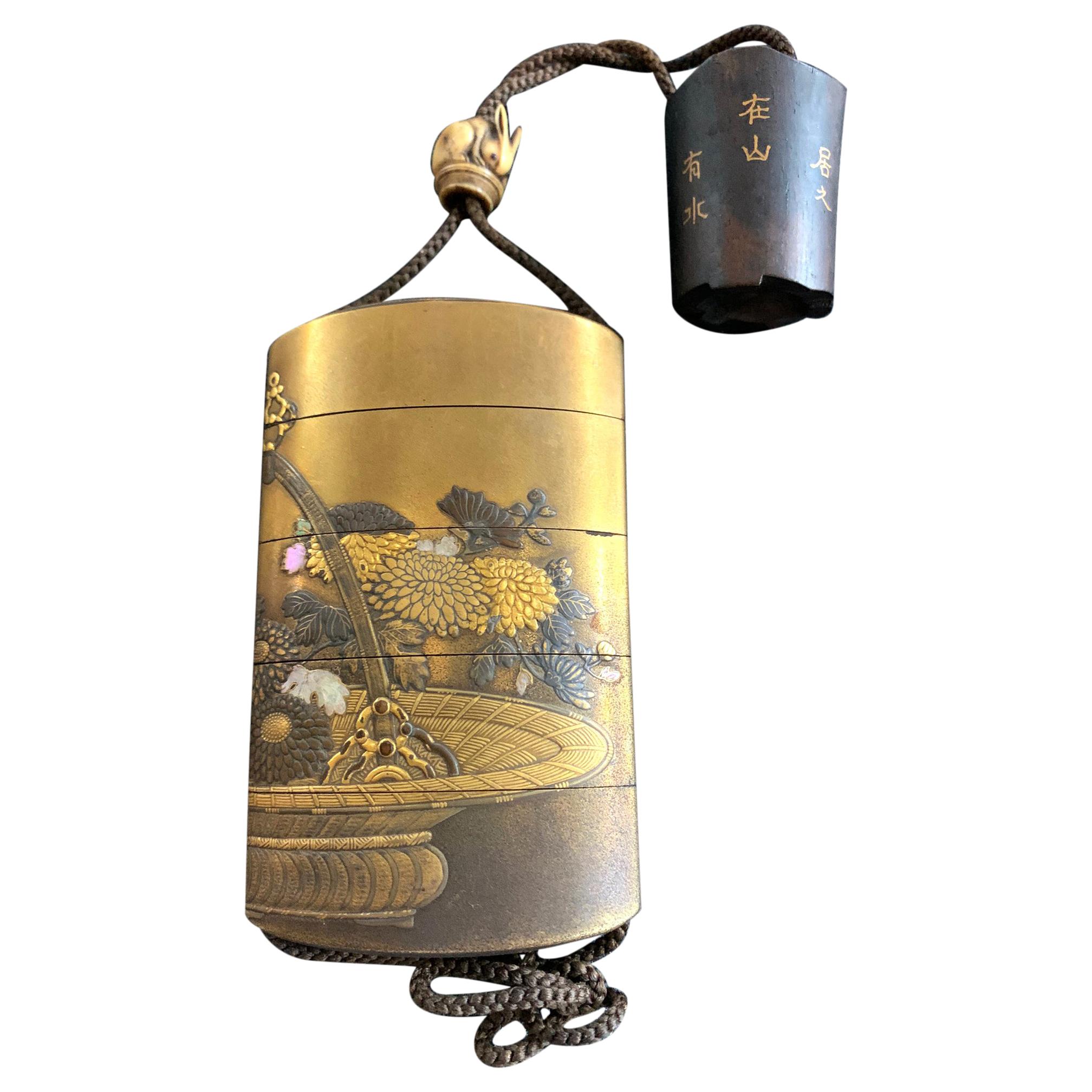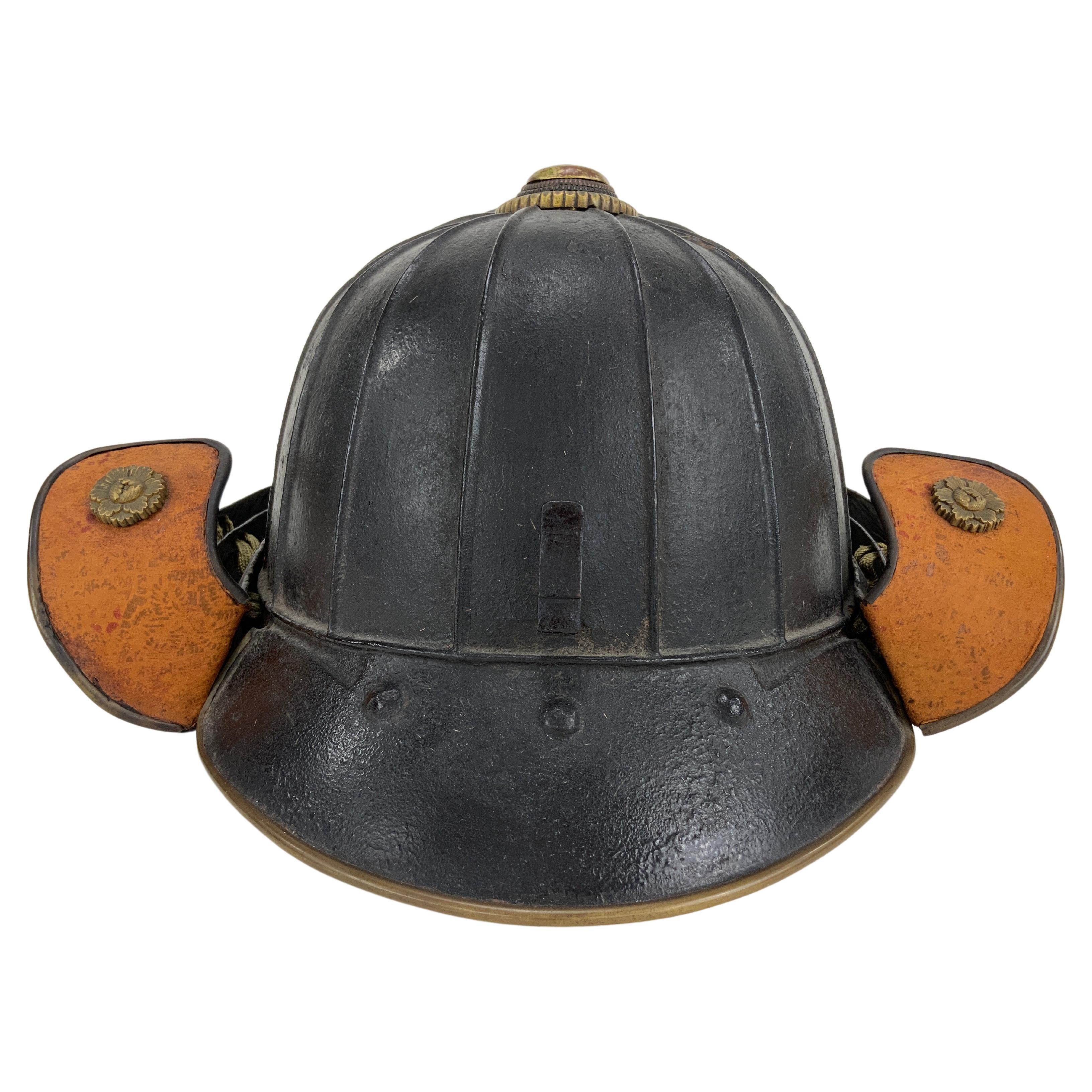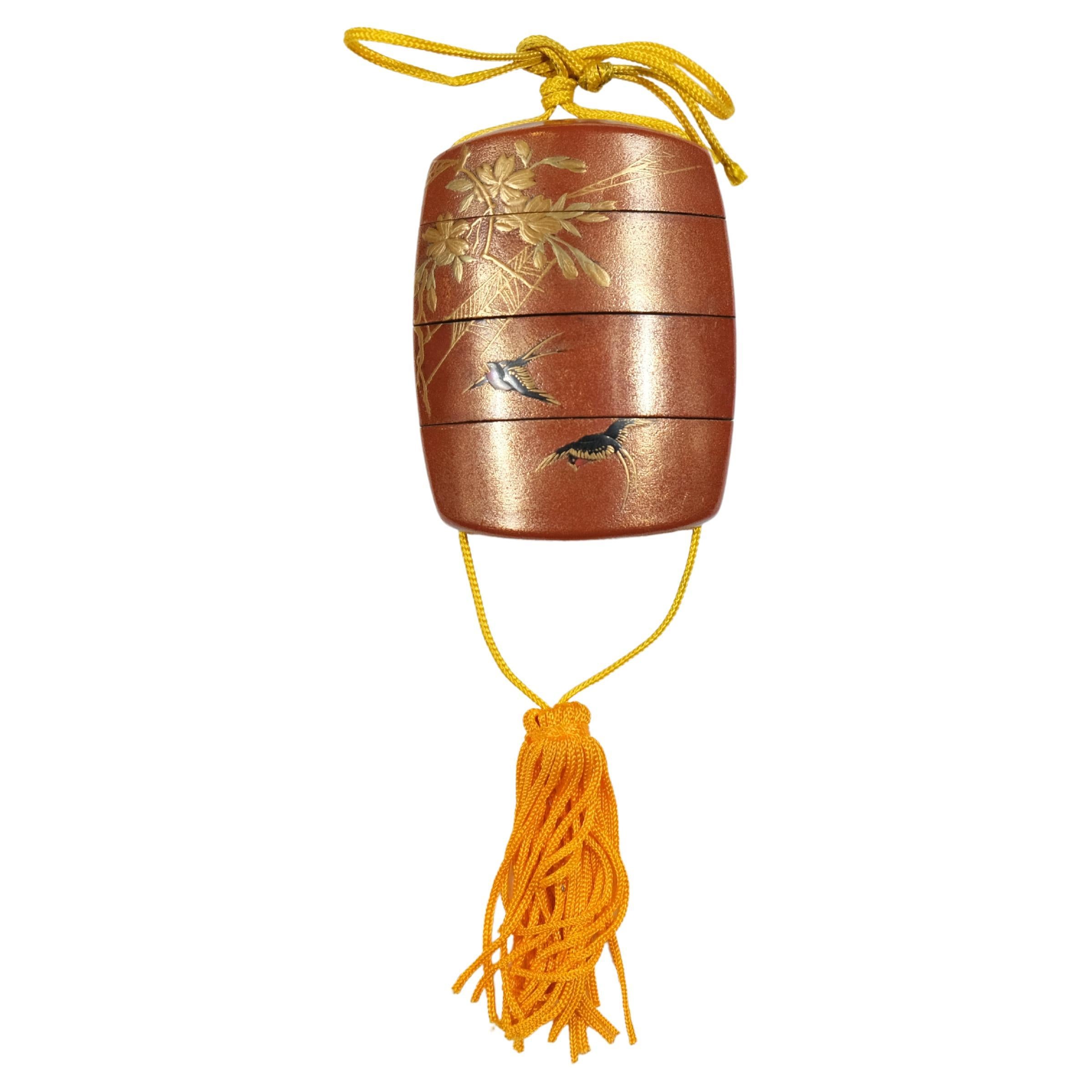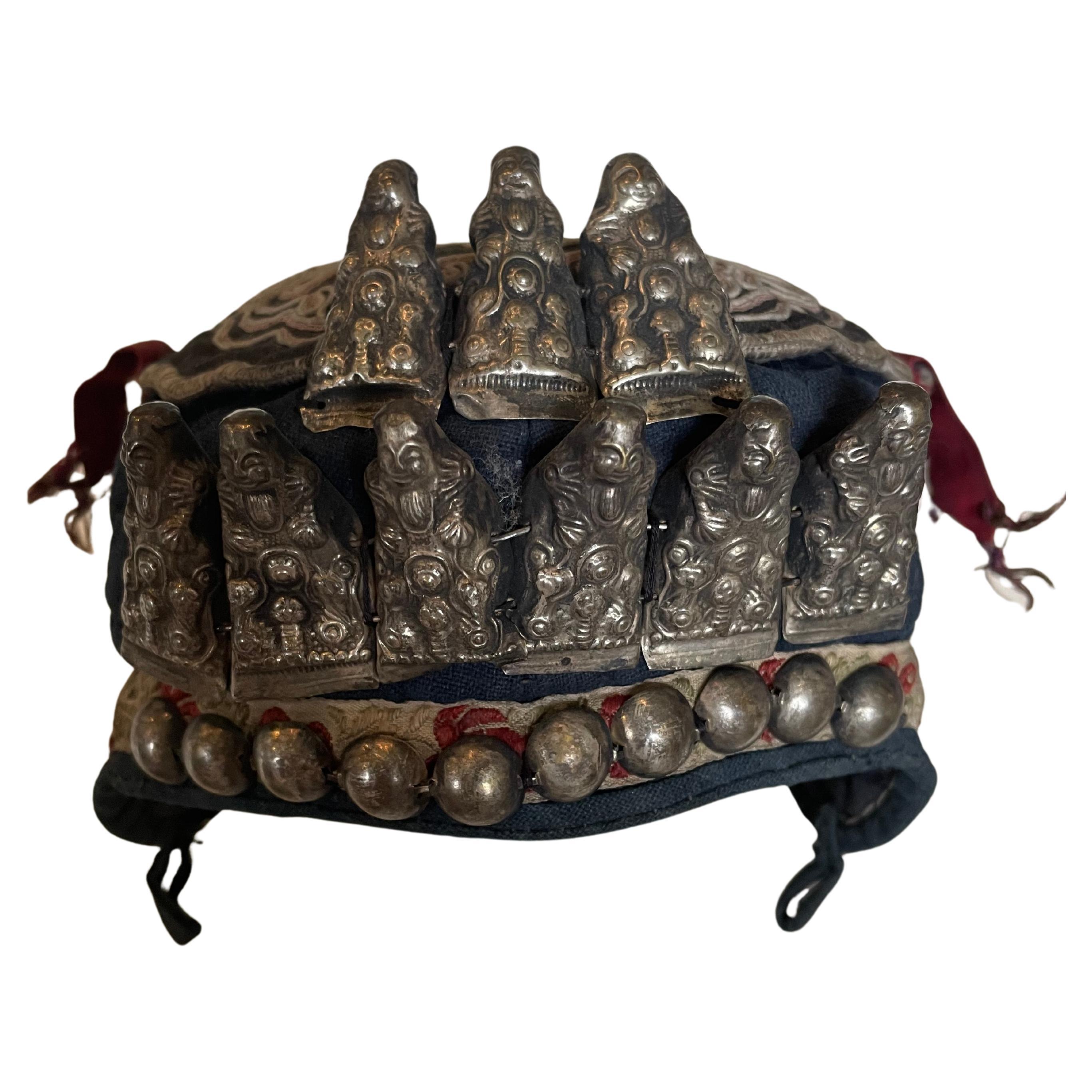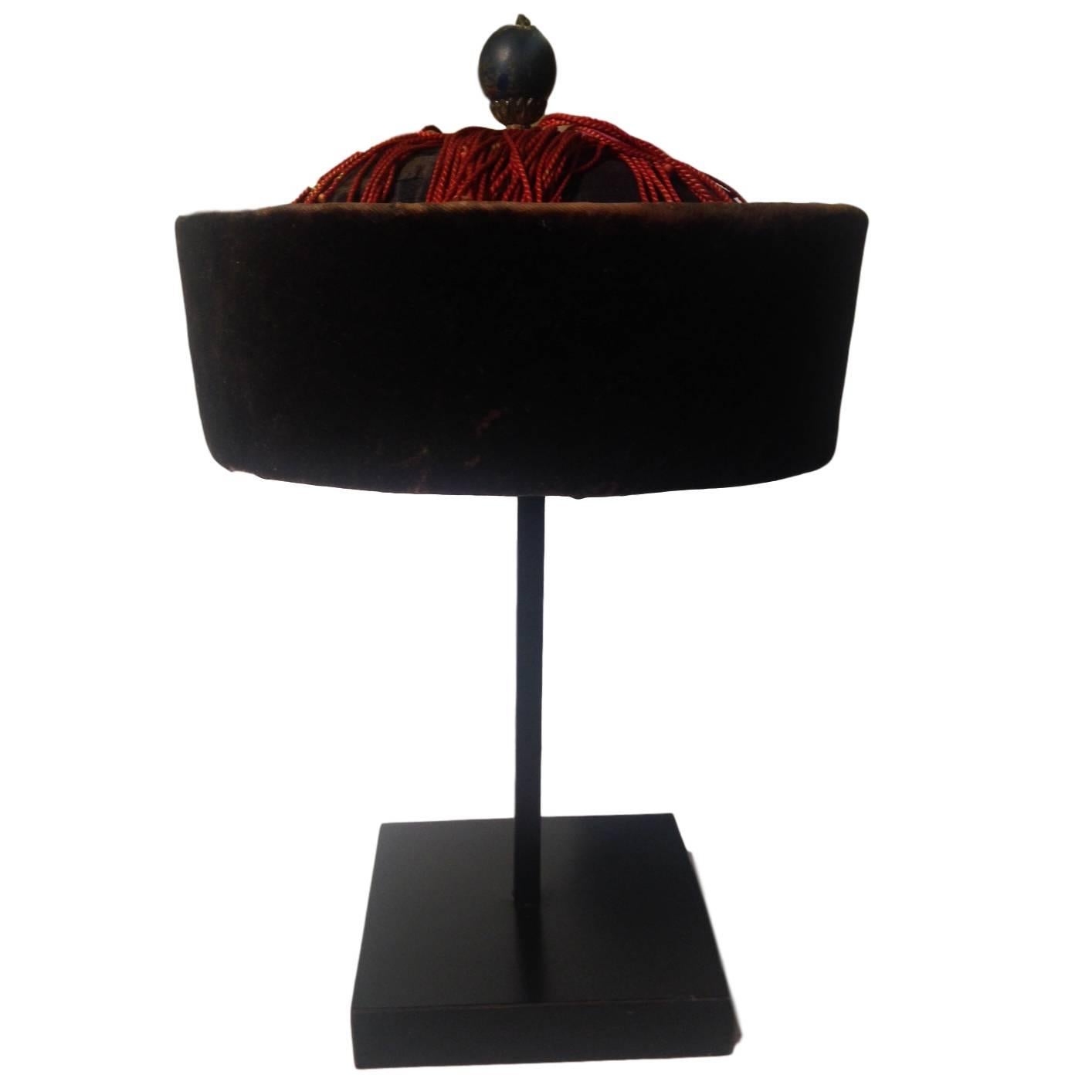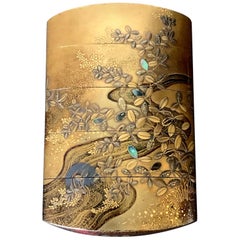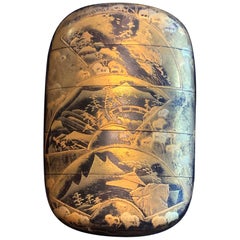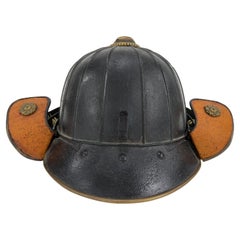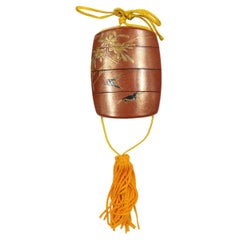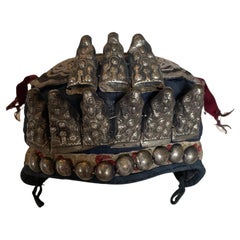Items Similar to Japanese Lacquered Samurai Jingasa Hat Edo Period
Want more images or videos?
Request additional images or videos from the seller
1 of 17
Japanese Lacquered Samurai Jingasa Hat Edo Period
$4,000
£3,077.07
€3,571.60
CA$5,640.95
A$6,318.82
CHF 3,318.87
MX$76,834.80
NOK 42,027.75
SEK 39,895.64
DKK 26,656.23
About the Item
A bespoken Japanese historical hat known as Jinggasa (militant hat) that was worn by samurai in Edo period (1603-1868) circa 18-19th century. There were several subtypes of Jingasa and this is a type called ichimonji gasa or hara gasa (flat type). It was were constructed from layers of paper and cloth with heavy surface lacquer with brass hardware accoutrement and tassels. It was made strong enough to be worn as a helmet and often waterproof. On Jingasa worn by higher ranks of samurai members, there was always a mon (family crest) in gilt lacquer on the surface as an identification.
This Jingasa stands out in its rather unusual decorations. The black exterior features a highly textured surface that resembles tree bark. The underside, which in most cases covered with a simple layer of monochrome lacquer, was lavishly decorated in gold leaf stripes and powder splashes on a bright red background. The overall visual effect is therefore very striking. The exterior surface also showcase a fifteen-leaf Sasa (bamboo) Mon toward the front, three tridents radiating from the metal tehen kanamono (the kiku shape hardware that covers the top center knot), and on the back, a ring (called kasa jirushi no kan) for the decorative agemaki bow. Underneath the hat, there are four rings where the red cord is fastened to be used to tie under the wearer's chin.
The Jingasa appears original with mellow patina and wears along the edges and on the surface that are consistent with its historical use.
- Dimensions:Height: 4 in (10.16 cm)Diameter: 16.5 in (41.91 cm)
- Style:Japonisme (Of the Period)
- Materials and Techniques:
- Place of Origin:
- Period:
- Date of Manufacture:18th-19th Century
- Condition:Wear consistent with age and use. Minor losses. Small historical losses (dumps and nicks), mostly along the rim, a couple on the black and red surface as well. Hardware appears original. Red cord/tassels in good shape, not sure if it is original. Present beautifully as it is with the patina.
- Seller Location:Atlanta, GA
- Reference Number:1stDibs: LU945023942912
About the Seller
4.9
Platinum Seller
Premium sellers with a 4.7+ rating and 24-hour response times
Established in 2006
1stDibs seller since 2010
565 sales on 1stDibs
Typical response time: <1 hour
- ShippingRetrieving quote...Shipping from: Atlanta, GA
- Return Policy
Authenticity Guarantee
In the unlikely event there’s an issue with an item’s authenticity, contact us within 1 year for a full refund. DetailsMoney-Back Guarantee
If your item is not as described, is damaged in transit, or does not arrive, contact us within 7 days for a full refund. Details24-Hour Cancellation
You have a 24-hour grace period in which to reconsider your purchase, with no questions asked.Vetted Professional Sellers
Our world-class sellers must adhere to strict standards for service and quality, maintaining the integrity of our listings.Price-Match Guarantee
If you find that a seller listed the same item for a lower price elsewhere, we’ll match it.Trusted Global Delivery
Our best-in-class carrier network provides specialized shipping options worldwide, including custom delivery.More From This Seller
View AllAntique Japanese Inro by Shigehide Edo Period
Located in Atlanta, GA
This exquisite four-case lacquered inro was dated to the latter part of 18th century to early 19th century (Edo period) and made by Shigehide. The opposite sides of the inro together features a lavish flower arrangement in a bamboo basket (ikebana). The detailed craftmanship was a true pleasure to behold. Mostly Takamaki-e (high relief) were used to texturize the delicate petals of the chrysanthemums, on which different shades of gold were used to create contrast. Raden (mother of pearl) shells were also used to highlight some leaves, rendering the piece an interesting balance of color and material. The interior was completed in a mottled gold finish. It was signed Shigehide on the bottom with a Kao. There is a small carved rabbit ojime bead...
Category
Antique Late 18th Century Japanese Japonisme Lacquer
Materials
Wood, Lacquer
Fine Japanese Lacquered Inro with Inlays by Kajikawa
Located in Atlanta, GA
A Japanese four-case lacquer inro by a member of Kajikawa family circa 19th century (late Edo to early Meiji period). It depicts a nocturnal scenery of a meandering stream surrounded by bush clovers, where a full moon is reflected on the water. It was masterfully decorated in gold and silver maki-e using a combination of techniques including takamakie, togidashi and kirigane as well as aogai (abalone shell) inlays. The stream was set between the slightly elevated banks, adding to this piece a already strong three-dimensional composition. The interior was decorated in gold nashiji. It was signed on the bottom "Kajikawa Zou" (made by Kajikawa and a pot seal centered with "Ei" in Kanji. In one of the compartment, there is a katakana mark, appears to be a name, possibly the owner.
Kajikawa clan was one of the most famous lacquer artisanal family established in the 17th century. Many well known members over the generations produced lacquer art in a wide range of formats, but two third were signed only with the family name such as this one. It is therefore not possible to pinpoint the exact author of this piece.
Provenance: This inro was purchased as lot 349 in Christie's New York sale Japanese...
Category
Antique 19th Century Japanese Japonisme Lacquer
Materials
Shell, Wood, Lacquer
Japanese Inro by Koma Koryu Edo Period
Located in Atlanta, GA
A four-case lacquered inro by Koma Koryu circa 19th century late Edo period. The inro features a pair of Chinese mandarin duck resting under a bundle of blooming irises on the pond. ...
Category
Antique 19th Century Japanese Japonisme Lacquer
Materials
Wood, Lacquer
Fine Japanese Lacquered Inro by Yutokusai
Located in Atlanta, GA
A four-case lacquered Japanese inro by Yutokusai (Gyokkei), a lacquer artist active from 1845-1900 (end of Edo to Meiji period). The slightly round inro features a very intricate design with three unfolded fans on the front and two on the back: each reveals a vignette landscape scenery, likely real places in Japan. Using a combination of hiramaki-e and slight takamaki-e, the artist deftly created the pictures with fine details, rendering the inro as a miniature artwork...
Category
Antique 19th Century Japanese Japonisme Lacquer
Materials
Wood, Lacquer
Japanese Lacquered Maki-E Natsume in Kodaiji Style
Located in Atlanta, GA
A Japanese lacquered tea caddy (known as Natsume) with fine Maki-e decoration circa 18-19th century Edo to Meiji period. The large-sized nat...
Category
Antique 19th Century Japanese Meiji Lacquer
Materials
Wood, Lacquer
Japanese Lacquered Gold Maki-E Naga Fubako Meiji Period
Located in Atlanta, GA
A Japanese lacquered wood Naga Fubako (a long box used to store document or large scroll painting), circa 19th century Meiji period. The rectangular box features an unusually deep lipped lid with slightly rounded corners, a conforming lower box with bronze medallion rings with tasseled...
Category
Antique 19th Century Japanese Meiji Lacquer
Materials
Wood, Lacquer
You May Also Like
Japanese Samurai Helmet Kabuto Edo Period (1603-1867)
Located in Hampstead, QC
A Japanese Samurai black-lacquered helmet (kabuto) in suji bachi style and of a goshozan shape consisting of the:
- main dome (hachi) made from 16 plates in natural iron riveted to...
Category
Antique Early 19th Century Japanese Edo Metalwork
Materials
Iron
Lacquer inro, Japanese, Late 19th c.
Located in Stockholm, SE
A fourpart Japanese lacquer Inro. the lacquer is red with motives of a spider with its web in gold and two flying cranes. The lowest part of the inro has a crack on one side.
Category
Antique Late 19th Century Japanese Lacquer
Materials
Lacquer
19th c. Chinese Qing Dynasty Children's Hat
Located in Dallas, TX
19th c. Chinese Qing Dynasty children's hat
Category
Antique 19th Century Chinese Antiquities
Materials
Silk
19th Century Chinese Court Official's Winter Hat
Located in Dallas, TX
This 19th century Chinese court official's winter hat is made of soft black velvet and is covered with red silk fringe. The dark blue knob on the top indica...
Category
Antique 19th Century Chinese More Asian Art, Objects and Furniture
Materials
Silk, Velvet
18th Century Hirate Clan Samurai Armor with Signed Kabuto Helmet
Located in Fukuoka, JP
This is a truly exceptional set of 18th century Samurai armor that is sure to impress any collector or enthusiast. The patinated iron used in its construction has aged beautifully, giving the armor a truly unique appearance that is sure to catch the eye. The brocade silk and cotton padding used to line the armor not only provide a comfortable fit for the wearer, but also add an extra layer of decorative flair.
One of the most striking features of this armor is the crests of the Hirate samurai clan that adorn it. These crests are a symbol of the clan's identity and heritage, and their presence on the armor speaks to the deep connection between samurai warriors and the clans they belonged to.
The Kabuto...
Category
Antique 18th Century Japanese Antiquities
Materials
Iron
Antique Burmese Bronze Temple Gong with Mallet and Raised Center
Located in Yonkers, NY
An antique Burmese bronze temple gong with mallet. This exquisite antique Burmese bronze temple gong captures attention with its traditional circular form and raised center. Featuring a rich, brown veined patina, this piece embodies the timeless beauty of Burmese craftsmanship. The gong comes with a mallet and a rope for easy hanging, adding authenticity and functionality to its striking design. Though the base is not included, its presence alone makes a bold statement, whether displayed as a decorative object or used in a more interactive setting.
Perfect for enhancing a living room, meditation space, or entryway, this temple gong serves as both a historical artifact and a stunning conversation piece. Its strong visual presence and the mallet's tactile invitation offer an engaging experience for guests. Whether hung as a sculptural wall accent or placed in a central area to invoke a sense of serenity and tradition, this Burmese gong...
Category
Early 20th Century Burmese Metalwork
Materials
Metal
More Ways To Browse
Red Lacquer Furniture
Black Gold Lacquer
Black And Red Lacquer
Edo Period Japanese Art
Asian Red Lacquer
Black Lacquer Gold Leaf
Japan Samurai
Japanese Red Lacquered
Bamboo Black Lacquered
Edo Period Gold
Japanese Black Lacquer Gold
Japanese Samurai Art
Japanese Gilt Wood
Japan Edo Lacquer
Japanese Hardware
Hat Tree
Black Lacquer With Brass Hardware
18th Century Tassel
